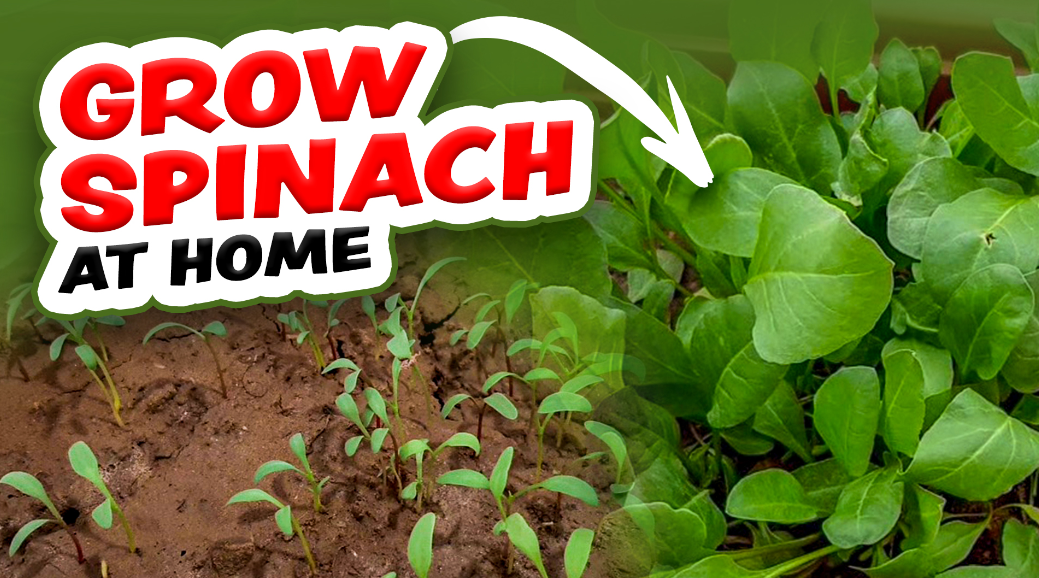How to Grow Spinach at Home
Spinach is a green leafy vegetable popularly known as Palak in India. It is a very healthy green vegetable having all the vitamins and minerals to build a strong immune system. Spinach can be grown at home. In this post, we will discuss how we can grow spinach at home.
Best season to grow Spinach
- Spinach can be grown for both the summer and winter seasons.
- For summers, it can mature from mid-February to April. If it is extreme summer, then seeds germinate but it will not grow properly.
- For winters, it can be grown from mid-August to October. During severe cold, its seeds do not germinate.
How to grow Spinach at home in pot
- The roots of the spinach do not go very deep nor spread very much. So, this plant does not require a deep pot.
- The pot should be wider in size in comparison to the depth of the pot, it can be 6 to 8 inches in height.
- Any old tub or bucket or rectangular plastic pot can also be preferred for planting spinach.
Perfect Soil for Spinach
Soil is a very important factor in gardening. To prepare the soil mixture for Spinach, take normal garden soil, sand, and any compost or fertilizer. Keep the ratio as Soil 50%, Compost 30% and Sand 20%.
❖ Clean the garden soil properly and add sand to it. In sand, seeds germinate faster plus sand does not make soil hard.
❖ To add nutrition to the soil, add any fertilizer or compost. We can also add liquid cow dung fertilizer.
❖ Mix all three things properly and keep this mixture for 3 days.
❖ Soil would be ready to use after 3 days.
How to Grow Spinach from Seeds?
- Spinach can be grown from seeds very easily and quickly.
- Seeds can be bought from nurseries or online and they are inexpensive.
- Spinach cannot be transplanted in another pot or container.
- From seeds sowing till the final product, only one container would be used. So select all the apparatus attentively.
Below are the steps to grow spinach from seeds
- Take the pot, make holes in its bottom, and cover the hole with any paper.
- Fill the pot with the prepared soil mixture.
- Place the seeds on the surface of soil at optimum distance, so that seeds can germinate properly.
- Cover the seeds with another layer of soil mixture.
- Spray water on the top layer of the soil. This layer should always be wet. Moisture needs to be maintained in the topmost layer of the soil.
- Keep the pot in a warm place but not under direct sunlight.
- Within five days, few germinated seeds can be seen.
By the 7th day, leaves would start coming but not true leaves, only cotyledon.
When seeds germinate, in the initial phase we get two types of leaves. The first two leaves (smaller one) which we get are called cotyledon. Cotyledons are part of the seeds only.
- After cotyledon, the second type of leaves that comes out are called true leaves. The structure of these two leaves is completely different from cotyledon.
- Be regular in giving water but do not keep the pot in direct sunlight till the point we get true leaves of spinach.
- Give water or fertilizer carefully, it should not disturb the seedlings as they are weak in the beginning phase.
Also, read: How to grow Coriander at home
Sunlight requirement for Spinach
Shift the pot in sunlight when true leaves have arrived.
- Initially, keep the pot in sunlight for 1 hour, the next day for 2 hours, and so on.
- Spinach can bear 2-8 hours of sunlight but the temperature should not be very high.
- Once a month, any fertilizer can be given to it.
How to harvest Spinach
Approximately, after 40-45 days homemade organic spinach can be harvested. It would be very fresh and pure.
- Spinach leaves are used not only once but many times, meaning after a few days of harvesting, they will grow again in 25-30 days and can be harvested again. Therefore, while harvesting, take care not to damage the plant and its roots.
- You can pluck this spinach 3-4 times, not more than that because of nutrition factors.
- For this, you can use garden scissors while cutting or pinching with light hands.
This was all about spinach planting. Grow it and enjoy it.
Follow our Social media channel:
1. Voice of Plant – YouTube Channel
2. Voice of Plant Facebook Page
3. Instagram Voice of Plant Channel
Happy Gardening!
